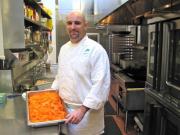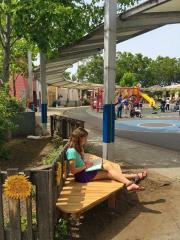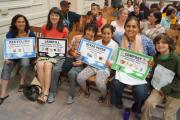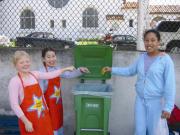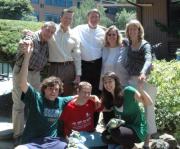The Greening of Head-Royce School
The Greening of Head-Royce: One School’s Journey Toward Sustainability
The Challenge We Face
On a warm, spring day in Berkeley in 2006, my wife Helen and I arranged an early viewing of the just-released film, “An Inconvenient Truth.” For a long time I had felt a growing concern about the state of our environment and the rapid, significant change in the climate that was both observable over my lifetime and well-documented by scientists. Having read Al Gore’s 1992 analysis of the environmental issue, Earth in the Balance, when it first came out, I felt I already knew something about the topic. But I was unprepared for my strong, emotional reaction. As I said to Helen on the walk home from the theater, “that was a profoundly depressing movie.” “Well,” she observed, “you could have that reaction, or you could do something about it. The last time I checked, you were a school principal, and you have a bully pulpit. Why don’t you use it?” That was exactly the kind of practical advice I needed. Then in my twenty-second year as the Head of Head-Royce School, a K-12, coeducational private independent school with 800 students in Oakland, California, I decided to make working on environmental sustainability my top personal and professional priority. And this is the story of how we changed Head-Royce, in a systemic way, to become a model green school.
Mission Is Key
A few days after seeing “An Inconvenient Truth,” I was working one afternoon in my office when sophomore, Alejo Kraus-Polk, dropped by with a question. “Paul,” he asked, (we were on a first name basis), “I am starting a new environmental club and was wondering if I could invite a speaker to school.” “Sure,” I answered, “who would that be?” The next week I joined two-dozen students and faculty who gathered to hear Deborah Moore, director of the Green Schools Initiative and a parent at the Prospect-Sierra School in El Cerrito. A Reed College graduate with a degree in physics with a master’s degree from UC Berkeley from the Energy and Resources program, Deborah had worked for many years for Environmental Defense. Her presentation was so clear and compelling, I approached her at the end of her talk, introduced myself, and asked, “Would you mind if I stole your ideas!” “Of course not,” she said, “that was the whole purpose.”

In my work as a principal, I learned that the written word has great power. Earlier at Head-Royce, I had re-written the School’s mission to focus on scholarship, diversity and citizenship to clarify our special identity and to address community tensions that had emerged as our School culture changed. Later, more focused mission statements about citizenship, diversity, and academic excellence helped build community understanding and commitment to our efforts. To advance our environmental initiative, I drafted what became the School’s Green Mission Statement, endorsed by the Board of Trustees that November. The mission served to focus our attention on four key areas—efficient use of resources; a healthy, non-toxic campus environment; good, nutritious food; an ecological curriculum; and constructive community practices—and gave all community members a way to make their own contribution to changing the School. And in the spring of 2007, the Board approved a small but powerful change I proposed to the School’s overall mission, to add the simple words “love of nature.” With our “charter” in place, and with some basic principles established, we were ready to move forward.
Head-Royce Green Mission
As part of its mission to prepare global citizens, the Head-Royce School is committed to being a Green School. Aware of the significant environmental challenges we face in the 21st century, our School strives to be a leader in demonstrating how to establish a more sustainable way of living.
• Use resources in a sustainable way, by utilizing energy efficiently and by incorporating clean, renewable technologies in existing buildings and in new construction.
• Create a healthy educational community by offering nutritional food on campus, by expanding the on-campus green schoolyard garden program, and by participating in the farm-to-school program.
• Develop the educational program to emphasize ecological sustainability, environmental health, nutrition, personal responsibility and leadership.
• Ensure that the School environment is as free as possible from toxic substances or harmful chemicals.
• Urge the wider School community—faculty, administration, staff, parents, and alumni—to embrace the effort to pursue sustainable living practices.
Governance and Leadership Essential
One afternoon in the summer of 2006, my thoughts turned to the preparation of my annual goals for the Board of Trustees. Every year I crafted goals and negotiated a year’s plan with my Board. This time I decided to add a focus on environmental sustainability to “establish Head-Royce as a model Green School by creating a vision statement and action plan.” When my Board Chair, Bob Stein, received my draft, he said, “Well, we have a lot to do with our Master Plan rebuilding the campus and our Capital Campaign to raise the funds, but this looks ok; why don’t you include it.” That endorsement, and the eventual, enthusiastic support of the full Board, was critical, not only to the progress we made but to the rapid, urgent pace of change.
 We organized that summer for a major reform effort. The first step was to establish a twelve member Green Council to help coordinate our efforts. Recognizing that the impact of global climate change will likely be the most important issue for the generation we are now educating, I made sure a majority of the members were students, with representation from each division—Lower, Middle and Upper Schools--and also included faculty and administration leaders. Beginning to meet that summer, we quickly brainstormed specific goals we wanted to accomplish. Aware that we were in the middle of rebuilding the campus, we included environmental sustainability as a major focus for several key Board committees--Facilities Planning, Finance, and Educational Policies. As the 2006-07 school year opened, we were poised to make some major changes at Head-Royce.
We organized that summer for a major reform effort. The first step was to establish a twelve member Green Council to help coordinate our efforts. Recognizing that the impact of global climate change will likely be the most important issue for the generation we are now educating, I made sure a majority of the members were students, with representation from each division—Lower, Middle and Upper Schools--and also included faculty and administration leaders. Beginning to meet that summer, we quickly brainstormed specific goals we wanted to accomplish. Aware that we were in the middle of rebuilding the campus, we included environmental sustainability as a major focus for several key Board committees--Facilities Planning, Finance, and Educational Policies. As the 2006-07 school year opened, we were poised to make some major changes at Head-Royce.
Sustainability is a Community Practice
Dramatic improvements in environmental sustainability at Head-Royce could only happen with a team effort. To move things along, I set a broad agenda for the Green Council, and recruited a number of our most-engaged faculty leaders, including science teachers Molly Barrett, Jen Brakeman, Debra Harper, Ryan Garrity, Middle School teacher Andy Sparks and her husband Ben who is a recycling expert, and Upper School history teacher Paul Scott. Critical to the team’s work were the Facilities Director Jason Hassard, who had been quietly working on “greening the campus” for some time, and our Director of Finance and Operations Dennis Malone, who had orchestrated several building projects at the school and was leading the implementation of the Master Plan. In an early meeting, I told the group, “There are two rules in this committee: ready-fire-aim, and it’s better to ask for forgiveness than permission.” Cautioning them they would likely not sit on many committees of this kind, I urged them, “let’s get moving.”
The fact that key members of our Board of Trustees were behind this initiative was critical to its success. Our visionary Board Chair and architect, Jeff Horowitz, had earlier developed the framework of a master plan for Havana with a group he helped create called Urbanists International; when the Bush administration placed an embargo on that work, he was in search of a new project and found one: Head-Royce School. Today Jeff continues his extraordinary work on behalf of Avoided Deforestation Partners (ADP), one of the most successful international initiatives to reduce carbon emissions. His successors, all very accomplished lawyers completely dedicated to the School with a strong sense of our civic purpose--Lee Hanson, Bob Stein, and Charlie Freiberg--fully embraced the idea that we should green the School. The chairs of the Facilities Committee from 2006 to 2010, two lawyers with significant experience in construction, development, and city government, Peter Smith ’78 and Scott Verges, were very skilled in guiding the greening of our School’s master plan, which came to fruition at this very time. It helped that our former Board Chair, Peter Darbee, who had become CEO of Pacific, Gas and Electric, continued to offer the support of his utility company to guide our analysis of energy efficiency. Serving first on the Facilities Committee and then on the Board, Dan Kammen, UC Berkeley professor, physicist, international expert on solar energy, and member of the Intergovernmental Panel on Climate Change (IPCC) was instrumental in explaining that efforts to achieve energy efficiency were not only the right thing to do environmentally, they would contribute to a positive bottom line. And there were countless other leaders who stepped forward to advance our new mission. As a school head, I was clearly blessed with an extraordinarily talented team.
Focus on Resources
Quickly we began to assess our use of resources and to develop a plan to improve efficiency and incorporate renewable energy. An important first step was to breathe new life into our all but moribund recycling program. The Green Council designed and implemented a whole new campaign to change our community’s behavior. They researched and acquired a new system of snazzy recycling containers, created eye-catching, instructive posters to explain how to sort, exhorted the student body in assemblies, and slowly, but surely, began to effect a radical change. Embracing the dirty but vital task of the annual “trash audit,” they established a baseline that shocked us; in 2007 Head-Royce was producing about 75, 000 lbs of trash annually. The new mantra of the four Rs--reduce, reuse, recycle and rot--stimulated significant and dramatic changes. Within three years we had reduced a great deal of waste that was being generated, and we redirected roughly two-thirds, or about 50, 000 lbs to recycling and composting. The Council negotiated a contract with Waste Management to make possible curbside pickup of our organic materials.
With our Master Plan moving ahead swiftly and with our new World Languages Building in the design-development phase, I realized that we were about to miss an opportunity to green our new construction. In 2005 I first heard about the US Green Building Council when my son Peter told me he was considering a job there right out of college. Then our indefatigable Development Director, Linda Twichell, told me, “Paul, you need to embrace this idea.” She introduced me to her friend, Peter Doo, a school architect who at that time was on the Baltimore Green Building Council. Peter met me at the NAIS annual meeting in San Diego in February 2006 and explained the steps required to get LEED (Leadership in Energy and Environmental Design) certification as a green building, with its focus on site, energy, water, materials and air quality. Amazed at the clarity of this metric, I said to Peter, “That’s it?” “Yes,” he said, “it’s pretty straightforward.” Inspired by the idea we could make our building a teaching tool for environmental sustainability, I spoke to our Facilities Committee and asked that we consider shooting for LEED certification on the new Upper School building. There was resistance—it would cost more, we don’t have time to factor this into the master plan, the design and construction team had not done green buildings. At this point I invited Dan Kammen to make the case for us; flying in from London where he had just briefed Parliament on their national green plan, he succinctly explained to our committee that it was imperative to achieve LEED certification and move aggressively on solar energy. Our creative architectural team led by Jon Malick, Cahill Construction Company headed by Head-Royce parent Chuck Palley, and the Board Facilities Committee agreed we should embrace this vision.
In a remarkable coincidence, I discovered the next month that one of my twelfth graders, Andrew Wentworth, was conducting an analysis of our School’s potential for a solar installation for his Senior Project, with the assistance of his father Scott, who headed up solar initiatives for the City of Oakland. With Andrew’s plan in hand, our Development Office sought financial support for this project, and remarkably an amazing, anonymous donor embraced a bold plan to put 412 photovoltaic panels, a 60-kilowatt system, on top of our gymnasium. We moved ahead in 2007 to sign a contract and by late fall we had installed one of the biggest solar generation systems in Northern California, one that eventually produced approximately 35% of the energy required by the new facilities. The celebration of our new system, “We’ve Got the Power,” with all our 800 students, employees, parents, alumni and friends gathered in the gym, was inspiring.
Given my new understanding that solar systems save significant costs while greatly reducing carbon emissions, my wife Helen and I decided to make our own personal statement and install a 2.4 kw solar system on our home roof. This required an upfront investment, elicited an immediate rebate of a third of the system cost, and brought our house quickly to a “grid neutral” status. For the four past years, we have paid no money for electricity to run our home. In fact, with new regulations in effect, PG&E will send us a check this coming January.
In the spring of 2007 we broke ground on the construction of a new Upper School building, designed according to LEED standards. When the new building was dedicated in September 2008, we learned it had achieved a Gold rating, joining just 45 such schools nationwide. In two short years, Head-Royce had moved to become one of the schools leading the environmental sustainability movement in education.
A Healthy, Non-Toxic Environment
Back in the summer of 2006 when we crafted our new green mission, we stated that we wanted to ensure that the School “environment is as free as possible from toxic substances or harmful chemicals.” I had recently become aware of the Bay Area Green Business Program and realized that the process of obtaining certification could help us achieve that goal. Assembling members of our Green Council, I told them I wanted us to become certified that school year. While the team realized we were taking on an ambitious goal, and the head of the Green Business Program said it hadn’t be accomplished before in such a short timeframe, we set out at a furious pace to get this job done.
Led by our Science Department Chair Jen Brakeman, with key collaboration from fellow scientists Debra Harper and Mollie Barrett, the team assembled a group of student volunteers to conduct the necessary studies of the campus operations and recommend changes. Fortunately, our Facilities Director joined this effort with incredible zeal. The process involved close scrutiny of energy and water use, toxic and hazardous chemicals on campus, and the like. Eight months later, after half a dozen on-campus audits, we became only the third school in Alameda County to be certified a green business.
That fall at our Back-to-School-Nights in September, I reported to our parents on our significant accomplishment. This was one of the few times I could recall when the assembled group broke into spontaneous and sustained applause!
Revising the Curriculum
 When we launched our initiative in the fall of 2006, it quickly became apparent that as we worked to green the campus facilities we would need a companion process for the curriculum. Our Assistant Head and Academic Dean, Crystal Land, was ready to lead this initiative, having guided a number of K-12 curriculum studies in recent years. In November she took me aside and said, “Paul, I need you to speak to our Curriculum Committee about why this is important. The faculty needs to hear from you a rationale for the environmental theme in the academic program.” Reflecting on her challenge over the Thanksgiving holiday, I mentioned my need to Steve Costa, the owner of Pt. Reyes Books, when visiting with him that long weekend. “I think I have just the book for you,” he said, pulling off the shelf a crisp new copy of Ecological Literacy, by Michael Stone of the Center for Ecoliteracy in Berkeley. After reading the book that weekend, I was convinced their principles of eco-literacy—focusing on the head, the heart, the hand and the spirit--were just what we needed to guide our effort. Further, the theory of ecology presented by the Center’s founder, internationally renowned physicist Fritjov Capra, offered the clearest rationale for environmental education. The following Monday in the late afternoon I called the Center and introduced myself. “I’ve just read this book,” I explained, “and I would like to borrow the principles for my School.” “Absolutely,” they said, and “good luck in your venture.”
When we launched our initiative in the fall of 2006, it quickly became apparent that as we worked to green the campus facilities we would need a companion process for the curriculum. Our Assistant Head and Academic Dean, Crystal Land, was ready to lead this initiative, having guided a number of K-12 curriculum studies in recent years. In November she took me aside and said, “Paul, I need you to speak to our Curriculum Committee about why this is important. The faculty needs to hear from you a rationale for the environmental theme in the academic program.” Reflecting on her challenge over the Thanksgiving holiday, I mentioned my need to Steve Costa, the owner of Pt. Reyes Books, when visiting with him that long weekend. “I think I have just the book for you,” he said, pulling off the shelf a crisp new copy of Ecological Literacy, by Michael Stone of the Center for Ecoliteracy in Berkeley. After reading the book that weekend, I was convinced their principles of eco-literacy—focusing on the head, the heart, the hand and the spirit--were just what we needed to guide our effort. Further, the theory of ecology presented by the Center’s founder, internationally renowned physicist Fritjov Capra, offered the clearest rationale for environmental education. The following Monday in the late afternoon I called the Center and introduced myself. “I’ve just read this book,” I explained, “and I would like to borrow the principles for my School.” “Absolutely,” they said, and “good luck in your venture.”
Appearing the next Wednesday before the Curriculum Committee, composed of all department chairs and divisional leaders, I presented the Principles of Ecoliteracy for their consideration. Typically, the process of educational reform moves slowly in a school. I was amazed when, after the group read the draft I prepared, History Department Chair Karen Bradley looked up and said, “This is excellent and just what we need; I suggest we pass it today.” By unanimous consent, the Committee embraced the foundational ideas for a thorough K-12 reassessment of our academic program.
The Principles of Ecological Literacy
Education for sustainability requires, in addition to environmental knowledge, the acquisition of particular skills, values, and vision needed to put that knowledge into practice. Education for sustainable living cultivates competencies of head, heart, hands, and spirit to enable children to develop toward becoming citizens capable of designing and maintaining sustainable societies. A few of these competencies include:
Head
• The knowledge of ecology, the “language” of nature, and key concepts such as networks, nested systems, cycles, flows, development and dynamic balance
• The ability to think systemically about the world in terms of relationships, connectedness and context
• The ability to think critically, to solve problems creatively, and to apply environmental ethics to new situations
• The ability to assess the impact of human technologies and actions and to envision the long-term consequences of decisions.
Heart
• A deeply felt concern for the well-being of the Earth and of all living things
• Empathy and the ability to see from and appreciate multiple perspectives
• A commitment to equity, justice, inclusivity, and respect for all people
• Skills in building, governing, and sustaining communities.
Hands
• The ability to apply ecological knowledge to the practice of ecological design
• Practical skills to create and use tools, objects, and procedures required by sustainable communities
• The ability to assess and make adjustments to uses of energy and resources
• The capacity to convert convictions into practical and effective action.
Spirit
- A sense of wonder
- A capacity for reverence
- A deep appreciation of place
- A feeling of kinship with the natural world, and the ability to invoke that feeling in others.
Early in the new year, Crystal and I arranged a field trip to CEL to request their help in our work. Immediately, we knew that their staff, led by Education Director Carolie Sly, could provide valuable insight into our curriculum review. We signed a consulting agreement for a year that eventually was extended for three. Carolie began by auditing our entire curriculum that had recently been mapped and put on-line. Addressing the faculty in February 2007, she proceeded to show the many units and curricular themes that already incorporated the principles of ecoliteracy. At once there was a huge sigh of relief from the teachers. They were emboldened to build on their work to make systematic changes, to individual lessons, units, themes, and ultimately whole courses, proposing the creation of new Upper School seminars on Environmental Product Design and Advanced Placement Environmental Science.
 A master at guiding the best professional development, Crystal conceived of a summer reading program for the teachers in 2007 to get everyone intellectually engaged. The faculty read one of four books: Alan Durning, How Much Is Enough; Michael Pollan, The Omnivore’s Dilemma; Barbara Kingsolver, Animal, Vegetable, Miracle; or Elizabeth Kolbert, Field Notes from a Catastrophe. Devoting a day of opening faculty meetings to discussion and reflection, it was clear that the team was ready to vigorously embrace curricular change. In each of the next three years we continued the reading program, with regular reporting to the Curriculum Committee on how the academic program was evolving.
A master at guiding the best professional development, Crystal conceived of a summer reading program for the teachers in 2007 to get everyone intellectually engaged. The faculty read one of four books: Alan Durning, How Much Is Enough; Michael Pollan, The Omnivore’s Dilemma; Barbara Kingsolver, Animal, Vegetable, Miracle; or Elizabeth Kolbert, Field Notes from a Catastrophe. Devoting a day of opening faculty meetings to discussion and reflection, it was clear that the team was ready to vigorously embrace curricular change. In each of the next three years we continued the reading program, with regular reporting to the Curriculum Committee on how the academic program was evolving.
In my final year at the School, mindful of the need to ensure that our work would continue after my retirement in June 2010, I asked the faculty to redouble their efforts and participate in an Environmental Summit at our February faculty meeting. Each was offered one of three books to read that first semester: Lester Brown, Plan B 4.0: Mobilizing to Save Civilization; Daniel Goleman, Ecological Intelligence: How Knowing the Hidden Impacts of What We Buy Can Change Everything; Al Gore, Our Choice: A Plan to Solve the Climate Crisis. With a dozen Upper School Green Team students in attendance, Fritjov Capra addressed the group on how we can achieve a more sustainable world. Then in small groups, after discussing these works, each member of the faculty made a personal and professional goal that would guide their work going forward. I was enormously proud of their commitment.
A Great Healthy Food Program
When our School moved to its present location in the Oakland hills in 1964, the architects created a kitchen, and the cook, Auntie Mae, served morning snacks and delicious hot lunches to the girls. Over the years, however, the kitchen was eliminated and the multipurpose room that was used for dining was so engaged for other functions that the food program disappeared. By the time we started our master plan, Head-Royce meals were strictly brown bag, punctuated by periodic pizza days and supported by vending machines that included a good stock of soft drinks. In other words, our School’s approach to nutrition mirrored what had happened in the public schools. Our conversations about the Master Plan created an opportunity to change all that.
In June 2005 I was in Washington DC participating in “A Day on the Hill” I had bought at our School’s auction that gave me a chance to meet with our Congresswoman Barbara Lee. After a tour of the Congress and lunch with her, she said to Helen and me, “I have to go to a special event sponsored by the Edible School Yard Project; why don’t you come with me?” We whisked down the hill to The Mall where we discovered a small farm and enclosed dining area sponsored by Chez Panisse’s owner Alice Waters, who was trying to raise awareness of the importance of good nutrition in the schools. Waters created the Edible School Yard Project, operating in seventeen schools in the Berkeley Unified School District, which trains students to grow, prepare and serve nutritious food at lunchtime. She arranged a lunch with the nation’s top political leadership to promote federal support for this model program. We joined Senators Barbara Boxer, Hillary Clinton, and Tom Harkin as well as House Minority Leader Nancy Pelosi for a spirited conversation about an elegant idea. As we left, Barbara thrust her briefing book into my hands and said, “Paul, you’re obviously very interested in this; I hope you will embrace the project.”
Upon my return to School, I decided to incorporate what I called a Great Healthy Food Program into our Master Plan so that we could provide new dining facilities for students. Over the next year our Facilities Committee redesigned what was originally a small warming café into a full commercial kitchen with a handsome dining hall. I remember one day walking the campus with our architect John Malick and reflecting on the importance we both ascribed to the residential college dining hall we enjoyed at Yale. Inspired by the vision of bringing the community together with good food, John and the planning team created a handsome environment in the new Upper School.
As we anticipated construction in the fall of 2007, we turned to thinking carefully about the actual food program. In collaboration with the Edible School Yard, the Center for Ecoliteracy had prepared an outstanding guide called Rethinking School Lunch. We embraced their ten-point program that included the following Goals and Objectives: 1. Communications and Marketing, 2. Finances, 3. Facilities Design, 4. Healthy Food, 5. Food Policy, 6. Local Procurement, 7. Waste Management, 8. School Garden, 9. Curricular Integration, 10. Professional Development. I established a Food Council that was broadly representative of the community to shape our new program, including students, faculty, administrators, parents, and Board members. We hired a food purveyor, Epicurean, who worked in a few area schools and had a reputation for offering local, fresh, organic food of high quality.

An Ambitious Future
In the 2009-10 school year, as I prepared to conclude my tenure at the School, I was mindful of the need to ensure that the Green School Program be institutionalized. We prepared some ambitious plans for Head-Royce. Faculty and student members of our Green Council concluded a three-year project tracking our School’s carbon footprint and proposed, first to the Facilities Committee, and then the full Board of Trustees, a policy to reduce the School’s carbon footprint 20% by 2020 in line with California’s historic legislation from 2006, A.B. 32. This will be no small feat since the School has already achieved significant reductions, through the Master Plan that led to the creation of two new buildings and renovation of four buildings. Central to this plan was a proposal to quintuple the School’s solar energy generating capacity to nearly 300 kilowatts. Taking a bold leadership position the Board of Trustees in its May 2010 meeting voted to proceed with this plan, recognizing that it would require a significant, up-front investment of about $1M that would pay for itself in a relatively short time. We also established a new, part-time Sustainability Director position, and appointed Lower School science teacher Debra Harper to run the Green Council, orchestrate the work of the divisional, student Green Teams, and keep the flame alive. As I concluded my year’s at Head-Royce, I was gratified by the School’s remarkable commitment to being a model green school, and confident that the School would continue to lead in this field.
Encore Career
 Head-Royce inspired me to devote the 2010-11 school year to understanding the environmental movement in our nation’s K-12 schools. It is my intention to map this movement, identify areas where we can improve, and shape a role for me to play in my years after retirement as a school principal. It is also my belief that the kind of systemic change process we used at Head-Royce, involving an integrated, simultaneous effort to address resources, health, nutrition, curriculum, and community practice, is essential to success. For me, there is no more important issue we face than the impact of climate change that is already upon us. To give our children and our grandchildren a world as beautiful as the one we enjoy today, we all should make this commitment. Our lives depend upon it.
Head-Royce inspired me to devote the 2010-11 school year to understanding the environmental movement in our nation’s K-12 schools. It is my intention to map this movement, identify areas where we can improve, and shape a role for me to play in my years after retirement as a school principal. It is also my belief that the kind of systemic change process we used at Head-Royce, involving an integrated, simultaneous effort to address resources, health, nutrition, curriculum, and community practice, is essential to success. For me, there is no more important issue we face than the impact of climate change that is already upon us. To give our children and our grandchildren a world as beautiful as the one we enjoy today, we all should make this commitment. Our lives depend upon it.

